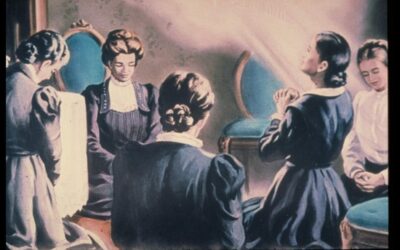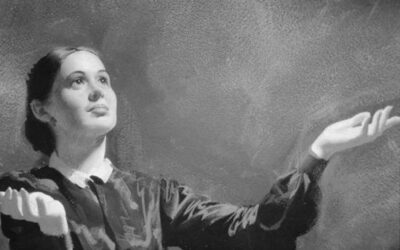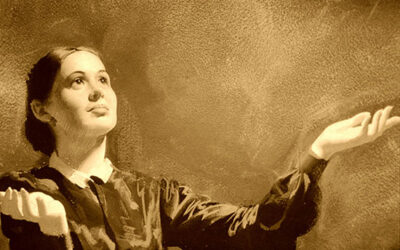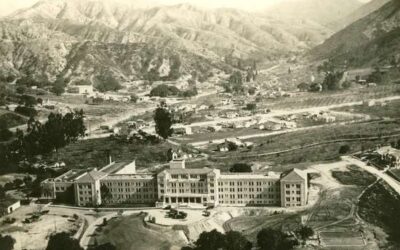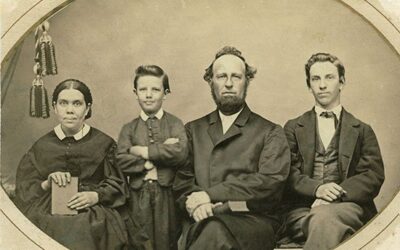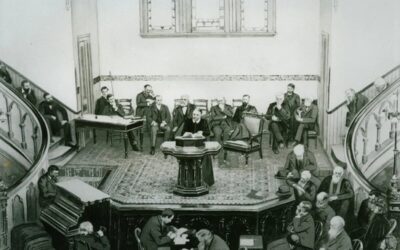When the Seventh-day Adventist Church was still young, a council of the church in Europe requested Ellen White, one of Adventism’s key leaders, to come to Europe. Despite the many obstacles, God led her there to help the new churches and members for two years.
Here’s an overview of her journey and all the ways God used her to spread the gospel there.
We’re going to cover:
Let’s first take a look at the timing of her trip.
When Ellen White traveled to Europe

Photo by Katherine McCormack on Unsplash
Ellen White journeyed to Europe in August of 1885 and remained there until 1887.
This was a time when airplanes were yet future. Ships were the only way to cross the sea, while on land, trains and horse-drawn carriages were typical transportation.
No air conditioning existed for the hot summer days, either, so traveling could be rather uncomfortable.
The Adventist Church at this time was just a few decades old, Following the Millerite Movement in the 1840s, those of the Advent Movement began meeting and studying together, but they didn’t organize into a church until 1863. And in Europe, the movement was even newer and it needed support.
On July 6, 1885, Ellen White began her trip across the United States from her home in St. Helena, California. On the way, she stopped in Kansas City, Missouri, Battle Creek, Michigan, and some other places, arriving in Boston in time for her August 7 embarkation on the ship S.S. Cephalonia.
She traveled with her son, William C. White, his wife Mary Kelsey White, and their three-year-old daughter Ella, as well as some other assistants and close church members.
It took 11 days to cross the Atlantic, and the trip was pleasant. Ellen White and her companions arrived in Liverpool, England, on August 18.
She stayed in Europe for two years. She returned to America by way of England again, departing from Liverpool on August 3, 1887, on the ship City of Rome.
This time she traveled with a smaller group: her daughter-in-law Mary and granddaughters Ella and Mabel. They arrived in New York on August 11.
Why Ellen White went to Europe

“Courtesy of the Ellen G. White Estate, Inc.”
Ellen White’s goal in traveling to Europe was to assist in the newly started work of the Adventist Church there. She went to encourage and strengthen the small congregations scattered across the Old World.
The request for her to come arrived after the Second European Council of Seventh-day Adventist Missions in 1884. The council members wanted her to visit the European mission. She also felt she could help Europe more in person because her writings hadn’t been translated into all the European languages.1
Before Ellen White was asked to visit Europe, another Adventist, J. N. Andrews, had been a key figure in the European mission. He was the first Adventist missionary to go to the continent and was deeply involved in the writing and editing of Adventist publications. Sadly, though, he had died in 1883.
The European council members also wanted Ellen White’s son, W. C. White, to help oversee some building projects—in addition to assisting his mother.
Despite all these reasons to go, Ellen White took eight months to decide to make the trip. It wasn’t that she didn’t want to see the Adventists in Europe; she deeply wanted to help where she could to share the gospel of Jesus’ second coming.
But she just realized the enormity of such a trip.
She was an older woman—nearly 60 years old—and was worn down from the ceaseless round of meetings, speaking, and travel. Her husband, James White, had died recently, and she was alone. In the Review and Herald, she wrote,
“To travel across the continent to leave from Boston for Europe in the heat of summer and in my condition of health, seemed almost presumptuous. … I had suffered great mental weariness and physical debility…. My courage was gone, and I longed for human help, one who had a firm hold from above, and whose faith would stimulate mine.”2
After many months of debating and worrying, her son William visited her and became that human help. He reminded her of past times when she had been worried and Jesus had helped her. She wrote,
“The love and blessing of God filled my heart, and from that hour I began to gather strength and courage.”3
And she embarked on a new adventure.
What Ellen White did in Europe
From the time she arrived in England to the time she left two years later, Ellen White devoted her attention to the churches and the people. She spoke at countless churches and halls and held numerous tent meetings, which were popular in the day. In between her speaking engagements, she helped start organizations and spent time writing and publishing her books.
She traveled to:
- England
- Switzerland
- Germany
- France
- Italy
- Sweden
- Norway
- Denmark
Many were excited to see and hear her speak in person.
The largest European crowd she addressed was in a military gymnasium in Norway. Sixteen hundred people packed in to hear her talk.4
Working with specific congregations
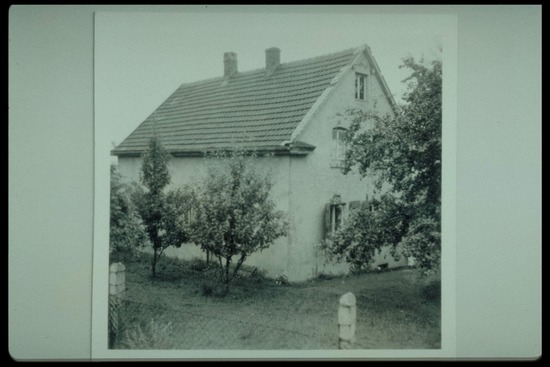
“Courtesy of the Ellen G. White Estate, Inc.”
Aside from speaking, Ellen White was involved in various church activities and in counseling congregations.
While in Tramelan, Switzerland, on Christmas Day in 1886, she performed the dedication ceremony for the first Seventh-day Adventist church building in Europe.5
On another occasion, she conducted Bible study classes in Basel, Switzerland, for the young people working in the Adventist publishing house there.6 She wrote to her son Edson about the progress of the classes:
“Our meetings are doing good. I wish there could be something of this kind every morning in the Review and Herald office.”7
As Ellen White spent time with various congregations, she also found ways to counsel them in their specific needs.
Church members in Christiana (now Oslo), Norway, were treating the Sabbath in a lax way by sending their children to school on that day and justifying it as acceptable because it was “doing good.” Ellen White counseled them:
“[Your] duty is plain, to obey God’s requirements at whatever cost.”8
Even though attending school on Saturday was a cultural norm, she encouraged them to place God’s principles first.
Another problem the members had was harshly criticizing each other for minor things.9
Ellen White realized that such nit-picking ignored the big picture, just as it did in the time of the Pharisees in the Bible:
“There is a conscientiousness that will carry everything to extremes, and make Christian duties as burdensome as the Jews made the observance of the Sabbath.”10
She began solving the problems by gathering all the members of the church after services one day and praying over them.
She also helped with challenges at a church in Vohwinkel, Germany. There also, unkind criticism had crept in and split the church.
While there, Ellen White had a dream about a group that obviously referred to the church in Vohwinkel. They were all involved in an unhappy and unpeaceful meeting when a stranger with a hidden face addressed their animosity and criticism. When he finished speaking, a light suddenly illuminated the man’s face:
“They [the church members] said one to another: ‘It is Jesus; it is Jesus!’ and then such confessions of sins as were made and confessions to one another. There was weeping, for the hearts seemed to be broken, and then there was rejoicing and the room was filled with the mellow light of heaven.”11
With this in mind, Ellen White went to the Vohwinkel Church that Sabbath. After services, she suggested the members have a social gathering. Everyone was surprised but attended, resulting in a successful time. Later, she gave appeals for peace and unity, all of which helped the members see the dangerous direction they were heading in.
Helping individuals
Ellen White did much to assist the fledgling congregations, but that didn’t sap her time or energy for individual people. One such person was young Edith Andrews, a niece of the Adventist missionary J. N. Andrews.
This girl was dying of tuberculosis, and in her last few months, Ellen White talked and studied Scripture with her. Edith was a friendly girl and a natural leader among the other young people, but she hadn’t always set the best example.12 Ellen White encouraged her to repent and accept Jesus.
Shortly before she died, Edith took the advice to heart. Ellen White later wrote:
“We have evidence that Edith’s life is not what it might have been, but her last days were days of penitence, repentance, and confession.”13
In the midst of all Ellen White’s busyness, one person was just as important to her as a whole congregation.
Starting camp meetings
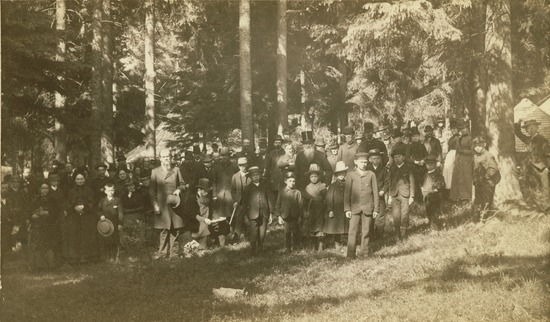
“Courtesy of the Ellen G. White Estate, Inc.”
Camp meetings—large meetings held in tents with singing and preaching—were in vogue in North American Adventist circles, but not yet in Europe due to the smaller Adventist population there. But through Ellen White’s efforts, the Adventist number grew large enough to support a camp meeting.
The first European camp meeting was held in Moss, Norway, in June of 1887.14 Ellen White was invited to speak at this significant event, and she did.
Writing and publishing
Besides all the preaching, teaching, and visiting Ellen White did over her two-year stay, she also spent a considerable amount of time writing and publishing. Her European headquarters was in Basel, a city in northwestern Switzerland. She would return there in between tours and when winter snow prevented her from traveling.
During this downtime, she wrote for The Review and Herald and compiled copy for her books.
She spent the first winter arranging and editing sermons and travel notes about Europe for a book called Historical Sketches of SDA Foreign Missions.15

Photo by Joanna Kosinska on Unsplash
The next winter, she took on the formidable task of revisiting and expanding the Spirit of Prophecy book The Great Controversy.16
Readers had been thrilled by the first version in 1884, which was an enlarged version of the original story in Spiritual Gifts. With her trip to Europe, Ellen White realized she needed to enlarge The Great Controversy and gear it toward an audience both inside and outside Adventism.
In Europe, she had the opportunity of visiting the site of the Reformation, including the Swiss cities Basel and Zurich and parts of Germany—all places she’d written about. Her son Willie wrote in a letter,
“During [Ellen White’s] two years residence in Basel, she visited many places where events of special importance occurred in the Reformation days. This refreshed her memory as to what she had been shown [in vision] and this led to important enlargement in those portions of the book dealing with the Reformation days.”17
She was also able to access the extensive library of J. N. Andrews, who had been an earnest scholar in the Adventist Church.
Touring and experiencing different cultures
Yes, Ellen White had gone to Europe to work, but not every moment was spent doing so. During her stay, she found time to take excursions for rest and relaxation.
For example, when she visited France in 1886, she stopped in Paris, where she toured the stock exchange, Versailles, and the tomb of Napoleon.18
The Adventists in Scandinavia also gave her opportunities to experience different cultures. On one visit, Ellen White sampled Swedish culture at breakfast. She described it this way:
“There was a round table with a cloth upon it and a flower pot in the center, and bread, a quarter of uncut cheese, hot milk, and fried cakes, which constituted our breakfast…. We were invited to come to the table, all standing. A blessing was asked and then we stood around the table, took something in our hands, and walked about, talking and eating.”19
She had experienced her first smorgasbord.
Besides seeing these unique examples of culture, Ellen White went on walks and picnics in the countryside of the places she stayed, especially around Basel.
Ellen White’s European legacy
Ellen White’s European tour brought lasting encouragement and support to the Adventists there.
At a time before television, radio, and cell phones, seeing leaders in person was an inspiring thing for a group. It was no different for the Adventist Church.
L. H. Christian, president of the European Adventist Division in the 1920s, wrote about Ellen White’s influence years after she visited:
“The advent movement in Europe would never have been the same if it had not been for her visit…. [W]hen now and then in later years a few disloyal ones ridiculed and belittled the gift of prophecy and the servant of God, our people said: ‘We know better. We heard her speak. We have seen her humble, godly, inspiring life. We have her books, and they agree with the Bible and deepen our love for Jesus.’”20
The words of the Europeans sum up Ellen White’s legacy. Not only did she encourage and support individual congregations with her counsel but she also helped many more learn about the truth of the Bible through her evangelism efforts.
Traveling in Europe also helped her realize the need for translating her books into other languages so the Adventist message could reach non-English speakers. She worked with the publishing houses in Switzerland and England to achieve those goals.
In addition, Ellen White used her European experience to enrich her book The Great Controversy.
She had seen places and people in her visions, but sometimes she hadn’t known where or who they were or when they took place. Being in Europe expanded her understanding.
Being outside North America for the first time, Ellen White learned a lot too. She saw firsthand how different the thinking and culture was in the European countries, but she also realized, under all the exterior differences, how similar everyone really is—whether they’re in Michigan or Italy. It paved the way for her ministry in other countries, such as Australia.
Ellen White had set out to spread the gospel of Christ in Europe. Through her encouragement and support, the European churches today can reach even more people with that same message.
Read more about her visit to Europe in the book Ellen G. White in Europe 1885-1887 by D. A. Delafield.
Also get a peek into The Great Controversy, the significant book Ellen White revised in Europe.
- “Establishing the British Mission of the Seventh-day Adventist Church 1863-1887: Chapter 8,” British Conference Union of Seventh-day Adventists, Adventisthistory.org.uk. [↵]
- White, Ellen G, The Review and Herald, September 15, 1885. [↵]
- Ibid. [↵]
- Delafield, D. A., Ellen White in Europe, (Review and Herald Publishing Association, 1975), p. 122. [↵]
- Ibid., p. 247. [↵]
- Ibid., p. 212. [↵]
- White, Ellen G, Letter 105, 1886. [↵]
- Delafield, p. 121. [↵]
- Ibid., p. 119. [↵]
- Ibid., p. 120. [↵]
- Ibid., p. 278. [↵]
- Ibid., p. 88. [↵]
- White, Ellen G, Manuscript 30, 1885. [↵]
- Delafield, p. 300. [↵]
- Ibid., p. 256. [↵]
- Ibid. [↵]
- White, Arthur L., The Ellen G. White Writings, p. 127. [↵]
- Ibid., pp. 229–230. [↵]
- White, Ellen G, Manuscript 26, 1885. [↵]
- Delafield, p. 318. [↵]
Related Articles
More Answers
8 Pieces of Advice from Ellen White’s Counsel for Families
8 Pieces of Advice from Ellen White’s Counsel for FamiliesFamily—it can be the source of the most wonderful and frustrating parts of life. And it’s in the family that individuals develop their identities and learn the behaviors that either propel them forward or...
Ellen White’s Visions and Prophecies
The New Testament upholds prophecy as a spiritual gift that will continue to the end of time (Ephesians 4:11–14).
Ellen G. White’s Counsel on College Education
Ellen G. (Harmon) White, a significant co-founder of Adventism, is often known for her practical and spiritual guidance for proper childhood education. But she was also significantly involved in the development of Seventh-day Adventist higher education.
Ellen G. White or the Bible—Which is More Important to Adventists?
The Bible—without a shadow of a doubt—is the most important book. It’s the standard we use to test all other writings, including those of Ellen White.
Do Adventists Worship Ellen White?
Ellen White was a co-founder and leader in the Seventh-day Adventist Church from its beginning. Adventists believe that she had the prophetic gift (Ephesians 4:14; 1 Corinthians 12:28) and passes the biblical tests of a prophet.
Ellen White and the Sabbath
The Sabbath is an important topic in the Seventh-day Adventist Church. It shouldn’t surprise you, then, that Ellen G. White, a co-founder of the church, studied the Bible’s teachings on the Sabbath and wrote large amounts about it.
Are Any of Ellen G. White’s Prophecies Yet to Come True?
Yes. Some prophesied events have yet to happen. Ellen White, a co-founder of the Seventh-day Adventist Church, demonstrated many times over that she had the spiritual gift of prophecy (1 Corinthians 12, 14). Some of her predictions’ timelines have already passed, and those prophecies have been fulfilled.
What Ellen G. White Said About Using the Bible in Education
Ellen White, one of the founders of the Seventh-day Adventist Church, believed that education was not complete unless it was founded upon the principles of the Bible.
Ellen G. White’s Counsel on Christian Education
Ellen White, a co-founder of the Seventh-day Adventist Church, saw that the educational system during her time was lacking and looked for ways to improve it—not only in the United States but throughout the world. And as part of her life of ministry, she sought out practical ways to be better stewards of our minds, bodies, and the lives we’re given.
What Was Ellen G. White’s Counsel on Music?
At its core, music is a collection of tones, sounds, and rhythms that creates a melody. It’s also much more than that.
How Ellen White’s Teachings Can Improve Your Health
Healthcare in the nineteenth century was said to leave “more disease than it took away” with its use of bloodletting and “medicines” like mercury and arsenic. As people questioned these methods, new approaches popped up. But which ones were reliable?
Ellen White’s Spiritual Counsel on Marriage
As one of the founders of the Seventh-day Adventist Church, Ellen G. White was held in high regard. She was a prolific author and was heavily engaged in the mission of the denomination, prayerfully pursuing the guidance of the Holy Spirit.
Were All Ellen White’s Books Inspired?
As the most translated female author in the world, Ellen White wrote numerous books, articles, pamphlets, and more. These writings focused on developing Christian character, emphasizing Bible truth, practical tips for living well and staying healthy, and discussing effective methods of delivering the gospel message to the world.
What is the Spirit of Prophecy?
The Spirit of Prophecy, one of the spiritual gifts of the Holy Spirit, is described as “the testimony of Jesus” (Revelation 19:10) and, according to Belief 18 of the 28 Adventist Fundamental Beliefs about Scripture, it will be one of the distinctive characteristics of the remnant of devout believers in the end times (1 Corinthians 14:1-5; Revelation 19:10; Revelation 12:17).
How Ellen White Influenced the Adventist Health Message
Seventh-day Adventists are known for their emphasis on healthy living. And Ellen G. White was a significant influence in the development of this priority and practice among Adventists.
What Did Ellen White Say About End-Time Prophecy?
We can read in Scripture about the series of events and signs that lead up to the second coming of Jesus Christ. And it sounds pretty intense, to say the least. The symbolic nature of the language of prophecy also can make things tricky to understand at first.
What Were Ellen White’s Visions About the Adventist Church?
Led by the Holy Spirit, Ellen G. White was given many messages, counsel, revelations, and visions about the Bible, history, prophecy, and how we can apply biblical principles to our daily lives.
Ellen G. White’s Travels and Worldwide Mission
Though Ellen White, a co-founder of the Seventh-day Adventist Church, is best known for her ministry in the United States, she also traveled to twelve other countries in her lifetime—a big accomplishment in the 19th century when travel was strenuous and long.
Were All Ellen White’s Visions About the Future?
While the visions God gave Ellen White were often about the distant future or last-day events, she had many others that addressed different topics. They may not be discussed as much as her visions about the Second Coming or the End Times, but they tackled some timely topics for her day.
Ellen White and Adventist Healthcare—Ahead of Their Time
Medical care in the mid-1800s was primitive, to say the least. Basic concepts we take for granted—such as proper handwashing or recognizing the dangers of bloodletting—were nonexistent. And doctors often had little more than nine months of training!
What is the Spirit of Prophecy (Books 1–4) by Ellen G. White?
Applying biblical prophecy to history, recent events, and especially the future, can be a daunting task. Even a little scary for some. But even so, we can’t help but want to know more. We want to be prepared—to feel like we know how to weather the storm.
What Did Ellen White Teach About Vegetarianism?
One thing you might have heard about Seventh-day Adventists is their emphasis on a vegetarian lifestyle. If you’re wondering why that is, it goes back to our church’s humble beginnings:
What Does Ellen White Say About Prayer?
Have you ever had a burden you just had to tell someone, but you were afraid of being judged if you did? Ellen G. White, an important figure in the Seventh-day Adventist Church and a prolific writer, described prayer as talking to God in a personal way—He’s the friend we can tell everything to.
Who Were Ellen White’s Children?
Being the children of a woman with a prophetic calling from God had its blessings and its challenges.
In this overview, we’ll look at the highlights of the lives of Ellen White’s sons during her many years of ministry, as well as the ways each of them decided to serve Jesus Christ:
Steps to Christ: A Guide to a Relationship with Jesus
Whether you’re just starting your journey with Jesus Christ, are coming back after some time away, or have had a relationship with Jesus for years, using a book—in addition to the Bible—to guide or supplement that relationship can be helpful, comforting, and joyful.
How Can I Know Ellen White’s Messages Were From God?
It’s natural to be a bit skeptical when you hear about someone being “divinely inspired,” or that something is a “message from God,” etc. And we expect nothing different if you’re hearing about Ellen White, an influential co-founder of the Seventh-day Adventist Church, for the first time. After all, the Bible tells us that we’re supposed to test these things!
Was Everything Ellen White Said Divinely Inspired?
The Seventh-day Adventist Church believes that many of Ellen White’s messages were inspired by God. But that doesn’t mean everything she ever said was prophetic, or meant to be taken as direct instruction from God.
Ellen White and the Great Controversy
The Great Controversy is a book written by Ellen G. White, a co-founder of the Seventh-day Adventist Church. Written in the late 1800s, the book is the last in a series and describes the connection between Bible prophecy and post-biblical history. It also discusses factors that will characterize last-day events.
Was Ellen G. White Really a Prophet?
Seventh-day Adventists believe that Ellen G. White fits the Bible’s definition, description, and criteria of a true prophet. Her words and deeds have stood the test of time and always glorified God and the Bible above all else.
Didn’t find your answer? Ask us!
We understand your concern of having questions but not knowing who to ask—we’ve felt it ourselves. When you’re ready to learn more about Adventists, send us a question! We know a thing or two about Adventists.





